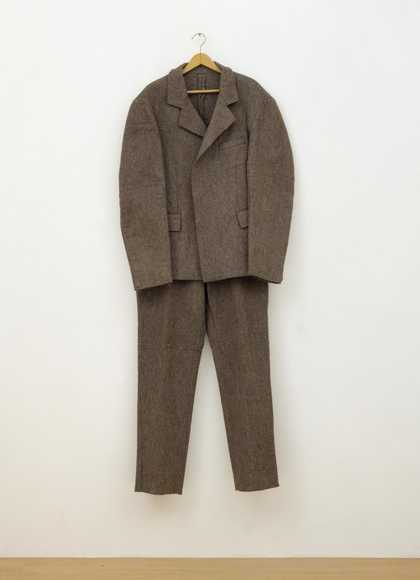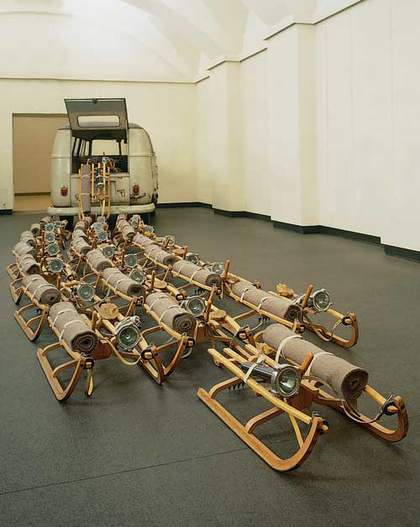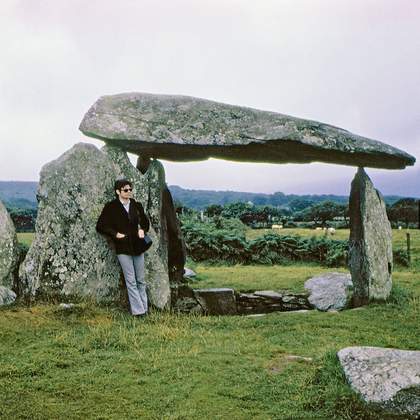The Bretton Estate near Wakefield, now the location of Yorkshire Sculpture Park (YSP), passed through various family lines, increasing in acreage and status until its heyday in the late eighteenth century.1 The improvements that formed the basis of the landscape evident today were begun by Sir William Wentworth (1683–1763) and reflected his early experience of the Grand Tour.2 Sir William was succeeded in 1763 by his son Sir Thomas Wentworth (later Blackett) (1726–1792), who set out to create a larger, more impressive park, in part, at least, as evidence of his culture and learning. A letter written to his sister Arabella in 1782 shows how he found the improvements to the Estate entertaining:
The lead trade and price have advanced which adds to one’s spirits as I can have more workmen to entertain me here in pulling down the walls and trees of the court and below the Terrase and laying all open to the Broad Ing and Park and my new Lake has been full and I have a ship the Aurora about 35 feet fore and aft, she sails well and has a good cabin for a dozen friends and a Menagery is almost finished in the Island next to the Temple Island and next year Outhouses and Stables will employ me and I may demolish the present kitchin.3
Sir Thomas commissioned the nurseryman Richard Woods to advise on the design and construction of the landscape in 1764 and the structure Woods established is largely still in evidence.4 Echoing the work of the fashionable landscape designers William Kent and Capability Brown, it has rolling views and vistas enabled by over one and half miles of ha-ha (concealed trenches). Plants were introduced and follies erected, accompanied by two large, man-made lakes, an Italianate garden and a formal terrace bordered by yew hedging with niches for statuary.
When Sir Thomas died in 1792 the Estate passed to his illegitimate daughter Diana Beaumont (c.1776–1831) who, apparently to bolster her fragile status,5 continued the extensive improvements of the lands she inherited and rigorously enforced their enclosure.6 Diana employed Robert Marnock as garden designer and it was under her ownership that the Estate is considered to have peaked in wealth and significance.7 After her death in 1831 Diana’s son, Thomas Wentworth Beaumont (1792–1848), continued with developments but began to sell off some of the Estate assets. This trend was accelerated by his son Wentworth Blackett Beaumont (1829–1907) who concentrated instead on the family’s Northumberland estates.8 The Bretton Estate entered a gradual decline and began to break up, concluding with the final sale of the Hall and immediate grounds to Wakefield District Council in 1948. In 1949 the Chief Education Officer of the West Riding of Yorkshire County Council, Sir Alec Clegg, founded an art teacher training college on the site with an ethos that echoed that of the Yorkshire-born art critic Sir Herbert Read, in particular his belief in the importance of creativity in education.9 YSP was founded by Peter Murray in 1977, at that time a lecturer at the college.10
Since its inception, YSP has encouraged creative engagement with the landscape and its history, inviting contemporary artists to make new work inspired by the environment of the Bretton Estate. Andy Goldsworthy creates and documents ephemeral work made using naturally available materials, site-specific installations for galleries that respond to their architecture and fabric, and semi-permanent interventions in the open air that reference the layers of activity on the land, such as changing ownerships and agriculture. He has developed a practice that, being physical and experiential as well as intellectual, relates to the ethos of YSP and its roots in Bretton Hall College. Goldsworthy first worked on the Bretton Estate in 1983 as a participant in the International Sculpture Centre Symposium where he created a number of ephemeral works, including a performance in which he physically entered the earth beneath a tree, documented through photographs and the title:
Climbed into rotten hollow.
At the base of a sycamore tree.
Just enough room in which to turn.
And crawl back out.
After which, I worked the edge with mud.
To make a black hole.
Yorkshire Sculpture Park.
September 1983.
It was while he was studying at Bradford College of Art in the mid-1970s that Goldsworthy first encountered the work of North American land artists such as Robert Smithson and seminal performance pieces such as Leap into the Void 1960 by Yves Klein. The possibility suggested by these works was of great significance to Goldsworthy, as he recalls: ‘There was a certain energy in the air at Bradford, and we were introduced to the work of performance artists and the American environmental artists. My first outdoor pieces were done there, but they weren’t to do with the land and looking back I can see that it was the works that I was shown that really exerted the greatest influence on me.’11 Goldsworthy’s art education was paralleled by his work as a farm labourer from the age of thirteen.12 This not only improved his physical strength and stamina but also nurtured an appreciation of the tensions between man and nature, and an understanding of natural cycles that proved to be of great importance to his work as an artist: ‘There is death in the field, but that gives way to growth. I felt that the studio was suspended from that process of life and death.’13
Goldsworthy’s explorations of process and material beyond institutional walls continued during his studies at Preston Polytechnic, where he was able to work on a nearby beach. In his performance Black Sand, Morecambe Bay, Lancashire. October 1976, for example, the artist dragged himself through sea water and sand with deliberate reference to Bog Action 1971 by the German artist Joseph Beuys, in which the latter aimed to draw attention to wetlands threatened by land reclamation along the Zuiderzee in The Netherlands.14 In seeking to understand the properties and possibilities of materials (he talked about learning the ‘sandness of sand’, for example),15 Goldworthy, like Beuys, aimed to reconnect with the fabric of the earth to better appreciate and rehabilitate natural and human ecologies (which, for Beuys, included not only environmental but political, economic, cultural and social systems).16
In 1987 Goldsworthy returned to YSP for a year-long residency during which he made temporary works for a week each season, documented in the publication Parkland.17 During this time Goldsworthy came to know the landscape of YSP as a participant rather than as an observer.
Twenty years later Goldsworthy was a natural choice to mark YSP’s thirtieth anniversary year, given his established relationship with the landscape of the Bretton Estate. In 2007 he created what he described as his most ambitious project to date across four indoor spaces and with three new outdoor commissions. His stated intention was to connect visitors with the layers of activity that had shaped the landscape of the Estate and to interrogate any perceptions of landscape as pastoral and bucolic. In doing so, Goldsworthy also intended to challenge possible misinterpretations of his own work.
Goldsworthy’s ephemeral practice has been the subject of several publications, including Touching North, which included visually striking photographs of the ice and snow works made by the artist at the North Pole in 1989.18 For the 2007 catalogue, however, the artist and YSP decided to focus on documenting the processes leading up to the creation of the works, as well as providing information relating to his artistic education and his experience as a farm labourer. Goldsworthy wrote:
Landscape is beautiful to look at, but as anybody who works with animals, on a farm, or with the land knows, it is also raw and harsh. I think that my art has suffered from the same misreading. The land, for many, is a pastoral backdrop to the weekend, an antidote to the nitty-gritty of urban life – the ‘real’ life. Obviously when you work outside and live in the countryside, it is not a pastoral retreat. Ultimately, it is a place where life, death, and decay occur in a potent and powerful way. It is the toughest place to work as far as I’m concerned. It is not some sort of idyll – it is often physically and psychologically uncomfortable and is at times severe and disturbing.19
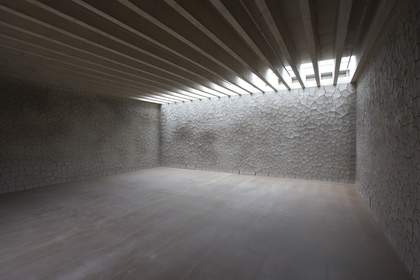
Fig.1
Andy Goldsworthy
Clay Room
Clay dug from the grounds of Yorkshire Sculpture Park
Dried, sieved, mixed with human hair
Reconstituted and applied to the gallery walls
Many participants
2007
Photograph © Jonty Wilde
Goldsworthy responded to the challenge posed by the large Underground and Longside galleries at YSP by constructing installations that connected directly to the architecture of the buildings and their context. Clay Room, for example, visually blurred the distinction between the building and the earth, a characteristic embodied by the Underground Gallery itself, which is built into a hillside like a modern day ha-ha, maintaining the uninterrupted views across the Estate. Inside, the walls of the gallery were plastered with twenty tonnes of clay dug from the Estate, mixed with three hundred litres of human hair (fig.1). As an extension of the cracked earth floors and walls that Goldsworthy has made since 1991, Clay Room intentionally evoked the sensation of walking into the earth itself. It was also significant that the clay was returned to the Estate, along with the DNA of the people who had been part of its facture, adding another layer to the landscape and also perhaps acknowledging that we are part of nature, our cycle its own.

Fig.2
Andy Goldsworthy
Installation shot of Longside Gallery, Yorkshire Sculpture Park, 31 March 2007 to 6 January 2008
Photograph © Jonty Wilde
Making reference to his previous employment as a farm labourer, Goldsworthy’s Longside Gallery installation acknowledged the fact that YSP has three tenant farmers whose agricultural activity coexists (but rarely interacts) with the organisation. In obscuring the picture windows of the space, with their carefully designed views and vistas of the Estate, with cow shit (fig.2), Goldsworthy drew attention to the tacit realities of a green and pleasant land.
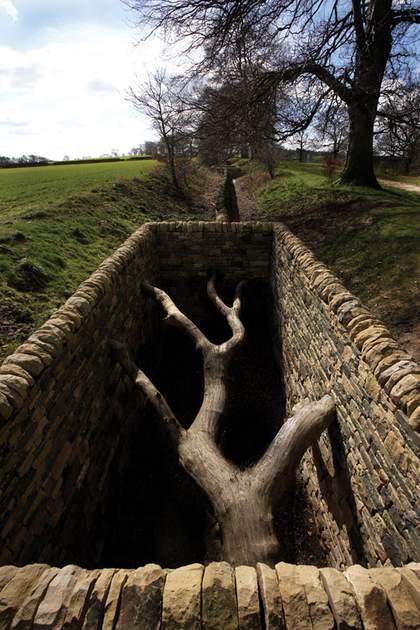
Fig.3
Andy Goldsworthy
Hanging Trees
Upper sections of oaks
Being felled locally
Supplied by Job Earnshaw
Oxley Bank
Yorkshire Sculpture Park
2006
Photograph © Jonty Wilde
Goldsworthy’s interrogation of traditional notions of the English landscape continued in three site-specific, built interventions for YSP, which made reference to its various ownerships and stages of remodelling. For the first he worked with one of the tenant farmers, Phillip Platt, to design a new sheepfold. Throughout his career, Goldsworthy has made or remade such folds, which function as shelters, sculptures and markers of farming activity. Shadow Stone Folds contains a huge slab of stone encouraging visitors to participate in making frost, snow or rain shadows, which the artist first made in 1984. The second commission, Hanging Trees (fig.3), was built directly into the eighteenth-century ha-ha, which was originally visible from the Mansion House before self-seeded trees interrupted the views. He wrote:
To me the ha-ha is part of what has always felt like a very one-sided view of the landscape, an uninterrupted idealistic view to be seen from the main house. The landscape is designed and laid out for this one perspective, the landowner’s perspective. A little before YSP, I was asked to come up with a proposal for Houghton in Norfolk where the ha-ha is also employed. I discovered that Robert Walpole oversaw a lot of the landscaping there and in the process removed an entire village and levelled hills because they interrupted his view. There is a hugely arrogant attitude attendant to this, wanting the place to appear perfect from that perspective.20
Goldsworthy sees the legacy of designs of this kind, often conceived to be best appreciated from the height of a carriage window,21 ‘as being potentially problematic, the move towards “drive-in” nature. Lay-bys with a sign. You look at the landscape and get back in your car’.22
Throughout his career, Goldsworthy has sought to understand the world by making art through physical contact. This has required access to land that in turn has posed issues around land ownership. This is demonstrated by Outclosure, an eight-feet high circular wall that was built within, and echoed, the wall of the eighteenth-century round wood (figs.4–5). The wood was not owned by YSP and permission had to be given by the private landowner. Dry stone walls are a significant, traditional feature of the English landscape, especially in the north. They are evidence of human control of the land and their appearance has been both the cause and the result of centuries of social conflict, particularly the repercussions of the Inclosure Consolidation Act of 1801.23 Outclosure, however, frustrates attempts to see inside, thus allowing nature to regain dominance over the space within.
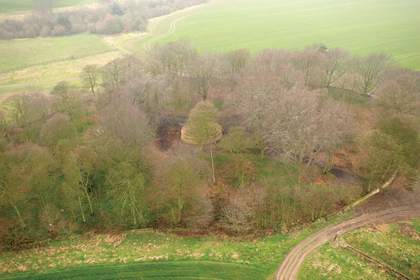
Fig.4
Andy Goldsworthy
Outclosure
Round Wood
Yorkshire sandstone
Quarried by Johnson’s Wellfield, Huddersfield
Sited with permission of Job Earnshaw and Bros Ltd
Yorkshire Sculpture Park
2007
Photograph © Jonty Wilde
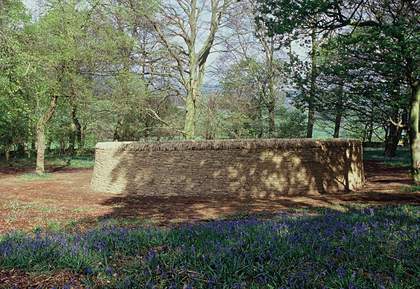
Fig.5
Andy Goldsworthy
Outclosure
Round Wood
Yorkshire sandstone
Quarried by Johnson’s Wellfield, Huddersfield
Sited with permission of Job Earnshaw and Bros Ltd
Yorkshire Sculpture Park
2007
Photograph © Jonty Wilde
In different ways Goldsworthy’s works at YSP have undermined Romantic ideas about the landscape, often pointing to the presence of decay and death within arcadia. At the time of Diana Beaumont’s passing it was written:
How uncertain are all human things! You and I saw Bretton Hall in all its splendour. All the horses have been sold, nearly all the servants have been discharged, the magnificent dining room is to be pulled down, the drawing room will probably be turned into a nursery and, alas, the noble conservatory is ordered to be taken down, piecemeal, and sold to the highest bidder – sic transit gloria mundi [thus passes the glory of the world].24
Goldsworthy’s art seeks not to lament the fragility of human life or futility of its efforts, but to understand it within natural processes: ‘Art is a reflection of an artist’s entire life. I would hope in my own work it reflects my life now and will continue to do that and lead me into old age and reflect that, and make sense of that, including death.’25 Through his YSP exhibition, and in excavating the associations of its landscape, Goldsworthy intended that the serious research and art historical context of his practice would be better understood. With its several hundred thousand visitors each year, YSP could be accused of conforming to the notion of the landscape as a weekend escape and idyll, a pleasure ground as it was conceived in the eighteenth century. But the Park’s intention and hope is that through artistic observation and intervention such as Goldsworthy’s, the complexities of man’s relationship within natural and constructed ecologies might be interrogated, better understood and appreciated.

